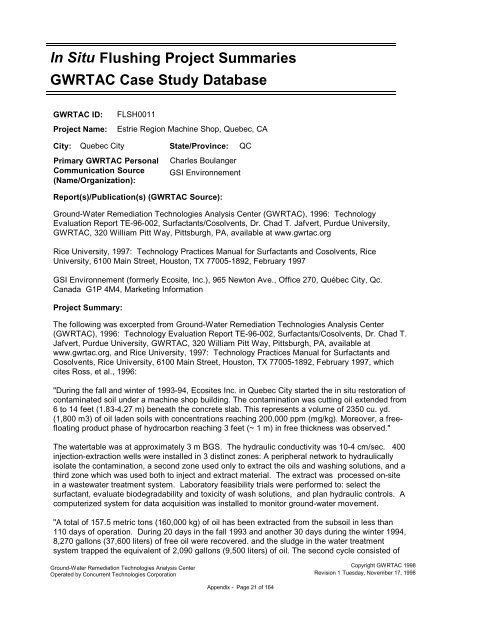Technology Status Report: In Situ Flushing - CLU-IN
Technology Status Report: In Situ Flushing - CLU-IN
Technology Status Report: In Situ Flushing - CLU-IN
Create successful ePaper yourself
Turn your PDF publications into a flip-book with our unique Google optimized e-Paper software.
<strong>In</strong> <strong>Situ</strong> <strong>Flushing</strong> Project Summaries<br />
GWRTAC Case Study Database<br />
GWRTAC ID: FLSH0011<br />
Project Name: Estrie Region Machine Shop, Quebec, CA<br />
City: Quebec City State/Province: QC<br />
Primary GWRTAC Personal<br />
Communication Source<br />
(Name/Organization):<br />
Project Summary:<br />
Charles Boulanger<br />
GSI Environnement<br />
<strong>Report</strong>(s)/Publication(s) (GWRTAC Source):<br />
Ground-Water Remediation Technologies Analysis Center (GWRTAC), 1996: <strong>Technology</strong><br />
Evaluation <strong>Report</strong> TE-96-002, Surfactants/Cosolvents, Dr. Chad T. Jafvert, Purdue University,<br />
GWRTAC, 320 William Pitt Way, Pittsburgh, PA, available at www.gwrtac.org<br />
Rice University, 1997: <strong>Technology</strong> Practices Manual for Surfactants and Cosolvents, Rice<br />
University, 6100 Main Street, Houston, TX 77005-1892, February 1997<br />
GSI Environnement (formerly Ecosite, <strong>In</strong>c.), 965 Newton Ave., Office 270, Québec City, Qc.<br />
Canada G1P 4M4, Marketing <strong>In</strong>formation<br />
The following was excerpted from Ground-Water Remediation Technologies Analysis Center<br />
(GWRTAC), 1996: <strong>Technology</strong> Evaluation <strong>Report</strong> TE-96-002, Surfactants/Cosolvents, Dr. Chad T.<br />
Jafvert, Purdue University, GWRTAC, 320 William Pitt Way, Pittsburgh, PA, available at<br />
www.gwrtac.org, and Rice University, 1997: <strong>Technology</strong> Practices Manual for Surfactants and<br />
Cosolvents, Rice University, 6100 Main Street, Houston, TX 77005-1892, February 1997, which<br />
cites Ross, et al., 1996:<br />
"During the fall and winter of 1993-94, Ecosites <strong>In</strong>c. in Quebec City started the in situ restoration of<br />
contaminated soil under a machine shop building. The contamination was cutting oil extended from<br />
6 to 14 feet (1.83-4.27 m) beneath the concrete slab. This represents a volume of 2350 cu. yd.<br />
(1,800 m3) of oil laden soils with concentrations reaching 200,000 ppm (mg/kg). Moreover, a freefloating<br />
product phase of hydrocarbon reaching 3 feet (~ 1 m) in free thickness was observed."<br />
The watertable was at approximately 3 m BGS. The hydraulic conductivity was 10-4 cm/sec. 400<br />
injection-extraction wells were installed in 3 distinct zones: A peripheral network to hydraulically<br />
isolate the contamination, a second zone used only to extract the oils and washing solutions, and a<br />
third zone which was used both to inject and extract material. The extract was processed on-site<br />
in a wastewater treatment system. Laboratory feasibility trials were performed to: select the<br />
surfactant, evaluate biodegradability and toxicity of wash solutions, and plan hydraulic controls. A<br />
computerized system for data acquisition was installed to monitor ground-water movement.<br />
"A total of 157.5 metric tons (160,000 kg) of oil has been extracted from the subsoil in less than<br />
110 days of operation. During 20 days in the fall 1993 and another 30 days during the winter 1994,<br />
8,270 gallons (37,600 liters) of free oil were recovered. and the sludge in the water treatment<br />
system trapped the equivalent of 2,090 gallons (9,500 liters) of oil. The second cycle consisted of<br />
Ground-Water Remediation Technologies Analysis Center<br />
Operated by Concurrent Technologies Corporation<br />
Appendix - Page 21 of 164<br />
Copyright GWRTAC 1998<br />
Revision 1<br />
Tuesday, November 17, 1998
















